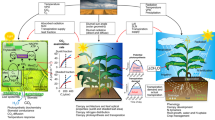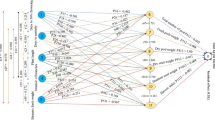Abstract
Water use efficiency (WUE) and total transpiration (T) are the two pivotal traits that determine the differences in total biomass (BM) accumulation. A significant genetic variability in these traits has been demonstrated in several crop species. Exploring of latter traits through breeding efforts to improve crop productivity have been rather slow in rice. To achieve success in crop improvement, it is important to understand the regulation of biomass accumulation by these physiological variables. Plant breeders often resort to the path analysis of the predictor variables and their influence on the response variables. Such analyses though have been extensively studied for yield attributing characteristics, very few studies have been conducted to understand the influence of the physiological traits such as WUE and T on biomass accumulation. Hence, a subset of random 40 Doubled Haploid Lines (DHLs) were examined in rice for the differences in WUE, T and BM. The statistical significance of path analysis indicated that WUE was controlled by the photosynthetic capacity, indicating that high WUE-DHLs would always have high biomass. This was further validated through a positive effect of mean transpiration rate on WUE through net assimilation rate. The outcomes of the current study suggest that the path analysis is a better approach to identify the genotypes with high WUE based on transpiration and photosynthetic rate.


Similar content being viewed by others
Abbreviations
- BM:
-
Total biomass
- NAR:
-
Net assimilation rate
- MTR:
-
Mean transpiration rate
- T:
-
Cumulative water transpired
- LAD:
-
Leaf area duration
References
Anonymous. (1989). MSTATC-C, a microcomputer program for the design, management, and analysis of agronomic research experiments. Michigan State Univ., East Lansing.
Araus, J. L., Slafer, G. A., Reynolds, M. P., & Royo, C. (2002). Plant breeding and drought in C3 cereals: What should we breed for? Annals of Botany, 89(7), 925–940.
Austin, R. B., Morgan, C. L., Ford, M. A., & Blackwell, R. D. (1980). Contributions to grain yield from pre-anthesis assimilation in tall and dwarf barley phenotypes in two contrasting seasons. Annals of Botany, 45(3), 309–319.
Dewey, D. R., & Lu, K. (1959). A correlation and path-coefficient analysis of components of crested wheatgrass seed production 1. Agronomy Journal, 51(9), 515–518.
Farquhar, G. D., & Lloyd, J. (1993). Carbon and oxygen isotope effects in the exchange of carbon dioxide between terrestrial plants and the atmosphere. In: Stable isotopes and plant carbon-water relations (pp. 47–70). Academic Press.
Gifford, R. M. (1987). Barriers to increasing crop productivity by genetic improvement in photosynthesis. Progress in Photosynthesis Research, 377–384.
Gravois, K. A., & McNew, R. W. (1993). Genetic relationships among and selection for rice yield and yield components. Crop Science, 33(2), 249–252.
Hussain, I. A., Prasad, T. G., Wright, G. C., Kumar, M. U., & Rao, R. N. (1999). Variation in transpiration efficiency and carbon isotope discrimination in cowpea. Functional Plant Biology, 26(6), 503–510.
Impa, S. M., Nadaradjan, S., Boominathan, P., Shashidhar, G., Bindumadhava, H. Y., & Sheshshayee, M. S. (2005). Carbon isotope discrimination accurately reflects variability in WUE measured at a whole plant level in rice. Crop Science, 45(6), 2517–2522.
Khush, G. S. (2013). Strategies for increasing the yield potential of cereals: Case of rice as an example. Plant Breeding, 132(5), 433–436.
Masle, J., Gilmore, S. R., & Farquhar, G. D. (2005). The ERECTA gene regulates plant transpiration efficiency in Arabidopsis. Nature, 436(7052), 866–870.
Passioura, J. B. (1986). Resistance to drought and salinity: Avenues for improvement. Functional Plant Biology, 13(1), 191–201.
Richards, R. A. (1996). Defining selection criteria to improve yield under drought. Plant Growth Regulation, 20(2), 157–166.
Richards, R. A., Rebetzke, G. J., Condon, A. G., & Van Herwaarden, A. (2002). Breeding opportunities for increasing the efficiency of water use and crop yield in temperate cereals. Crop Science, 42(1), 111–121.
Rockström, J., Karlberg, L., Wani, S. P., Barron, J., Hatibu, N., Oweis, T., et al. (2010). Managing water in rainfed agriculture—the need for a paradigm shift. Agricultural Water Management, 97(4), 543–550.
Samonte, P. B. S. O., Wilson, L. T., & McClung, A. M. (1998). Path analyses of yield and yield-related traits of fifteen diverse rice genotypes. Crop Science, 38(5), 1130–1136.
Sheshshayee, M. S., Bindumadhava, H., Shankar, A. G., Prasad, T. G., & Udayakumar, M. (2003). Breeding strategies to exploit water use efficiency for crop improvement. Journal of Plant Biology-New Delhi, 30(2), 253–268.
Udayakumar, M., Sheshshayee, M. S., & Nataraj, K. N. (1998a). Why has breeding for water use efficiency not been successful? An analysis and alternate approach to exploit this trait for crop improvement. Current Science, 74(11), 994–1000.
Udayakumar, M., Rao, R. C. N., Wright, G. C., Ramaswamy, G. C., Ashok, R. S., Gangadhar, G. C., & Aftab Hussain, I. S. (1998b). Measurement of transpiration efficiency in field condition. Indian Journal of Plant Physiology and Biochemistry, 1, 69–75.
Acknowledgements
Authors are humbled and gratefully acknowledge the grants provided by the Department of Science & Technology and Department of Biotechnology, Government of India. The Senior Research Fellowship to Dr. S. Nadaradjan from Indian Council of Agricultural Research is duly acknowledged.
Funding
Department of Biotechnology, New Delhi.
Author information
Authors and Affiliations
Contributions
M. Udayakumar, T.G. Prasad and M.S. Sheshshayee conceptualized and designed the experiments. S. Nadaradjan, S.M. Impa, P. Boominathan and S.G. Parsi performed experiment. Manuscript was drafted by S Nadaradjan, S.M. Impa, Hukkeri and M.S. Sheshshayee.
Corresponding author
Ethics declarations
Conflict of interest
The authors declare that they have no conflict of interest.
Additional information
Publisher's Note
Springer Nature remains neutral with regard to jurisdictional claims in published maps and institutional affiliations.
Supplementary Information
Below is the link to the electronic supplementary material.
Rights and permissions
About this article
Cite this article
Nadaradjan, S., Impa, S.M., Boominathan, P. et al. Dissecting the dependence of total biomass on physiological traits through path analysis. Plant Physiol. Rep. 27, 207–212 (2022). https://doi.org/10.1007/s40502-022-00649-w
Received:
Accepted:
Published:
Issue Date:
DOI: https://doi.org/10.1007/s40502-022-00649-w




